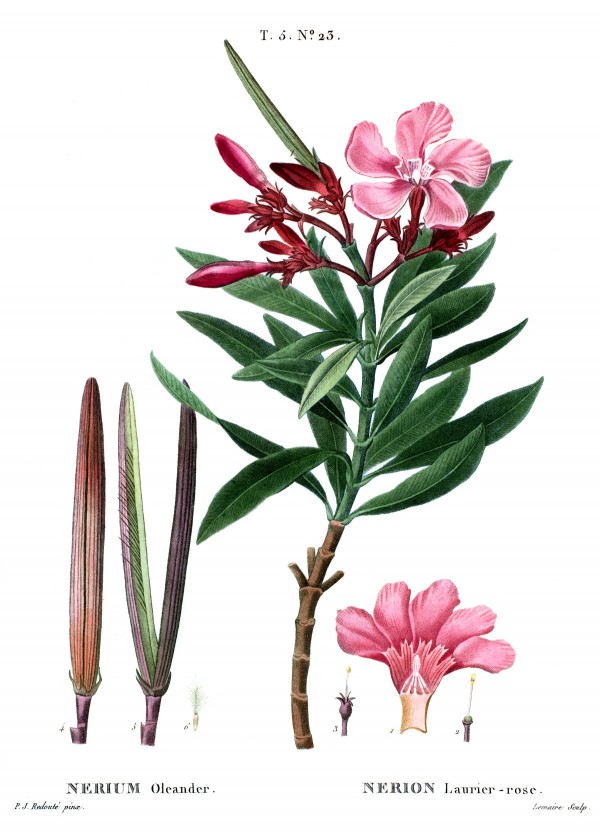Nerium oleander L. - Apocynaceae - oleander, rose-bay, Oleander, Rosenlorbeer
Evergreen subshrub, native to the Mediterranean, East Asia, cultivated worldwide as ornamental; leaves narrowly elliptiv, leathery; flowers fragrant, white, salmon, pink or purplish red. „All parts of the plant are extremely toxic. The seed-oil content is up to 58.5%.“
http://www.efloras.org/florataxon.aspx?flora_id=2&taxon_id=200018424
Total yield of essential oil collected from N.oleander flowers (origin: Saudi Arabia) by hydrodistillation was 0.1%. The major components were camphor (12%), eugenol (10%), thymol (8%), α-campholenal (5%), α-cubebene (3%), and caryophyllene (3%). Other interesting compounds present are pinene, myrcene, terpinolene, octanal, nonanal, bisabolene, myristicin, spathulenol and zingiberene e.g.
[Screening of chemical analysis, antioxidant, antimicrobial and antitumor activities of essential oil of oleander (Nerium oleander) flower., Ali, H. F. M., El-Ella, F. M. A., Nasr, N. F., Int. J. Biol. Chem, Vol.4, 2010, 190-202] http://scialert.net/qredirect.php?doi=ijbc.2010.190.202&linkid=pdf
„Oleandrin is a toxic cardiac glycoside found in oleander (Nerium oleander L.). Along with neandrin it is primarily responsible for the toxicity of the sap of oleander. Oleandrin has been used for many years in China and Russia for its properties as a cardiac glycoside, for both suicidal and therapeutic purposes as in treatment of cardiac insufficiency.“ https://en.wikipedia.org/wiki/Oleandrin
„A 37-year-old man presented two hours after the ingestion of “a handful” of oleander leaves (probably Nerium oleander) in a suicide attempt. Cardiotoxicity was evidenced by the presence of bradycardia (rate, 30 to 45) with sinoatrial nodal arrest and junctional escape consistent with a cardiac glycoside effect. The patient was treated empirically with a single dose of five vials (200 mg) of digoxin-specific Fab antibody fragments (Digibind®). The pretreatment digoxin level was 1.5 ng/mL. After treatment, the patient's rhythm stabilized with residual sinus bradycardia (rate, 56). The patient recovered uneventfully and was discharged on the fifth hospital day to inpatient psychiatric care.“
[Oleander poisoning: treatment with digoxin-specific Fab antibody fragments., Shumaik, G. M., Wu, A. W., Ping, A. C.,Annals of emergency medicine, Vol.17(7), 1988, 732-735]
„Cardenolides inhibit Na+,K+-ATPase, thereby increasing Ca++ level in heart muscle cells. As a result, oleandrin (and possibly other cardenolids) strengthens the contraction of the heart muscle while lowering the heartbeat. It is said to be weaker in action than digitoxin and oubain. In addition, cardenolides exhibit diuretic effects.“
[Medicinal Plants of the World. Ben-Erik Van Wyk and Michael Wink, Pretoria 2004, 215]
Toxic principle in all parts of the plant are cardenolides, which are also CNS depressant.
[Vikas Gupta, Payal Mittal, „Phytochemical and pharmacological potential of Nerium oleander: A Review.“, IJPSR (2010), Vol.1, Issue 3, 21-27] http://ijpsr.com/wp-content/uploads/2015/01/3Vol-1-Issue-3-Review-3.pdf
„The chemical composition and antibacterial activity of essential oils obtained from Nerium oleander (family Apocynaceae) [origin:Morocco] were examined. Their chemical composition was determined by hydro-distillation, analysed by GC/MS and GC-FID… The analyses for flower part resulted in the identification of 34 compounds, representing 93.21% of the total oil and the yields were 1.76%. The major component was nériine (22.56%), other predominant components were digitoxigénine (11.25%), Amorphane (8.11%), 1.8-cineole (6.58%), α-pinene (5.54%), calarene (5.12%), Limonene (5.01%), β-Phellandrene (4.84%), Terpinene-4-ol (3.98%), sabinene (3.22%), Isoledene (2.94%), 3-Carene (2.56%), Humulene (2.29%), β-Pinene (2.01%) and Cymen-8-ol (1.67%). The chemical compositions revealed that this study had compositions relatively similar to those of other Nerium oleander essential oils analyzed in other countries.“
[Antibacterial activity and chemical composition of the essential oil from flowers of Nerium oleander., Derwich, E., Benziane, Z., Boukir, A., Electronic journal of environmental, Agricultural and food chemistry, Vol.9(6), 2010, 1074-1084]

Duhamel du Monceau, M., Traité des arbres et arbustes que l'on cultive en France en pleine terre, t.5 p.23, 1801,
[Redouté, Pierre Joseph (Artist)]
CC0 (PD)
Nerium oleander
© Rolf Marschner (2008),
www.botanische-spaziergaenge.at